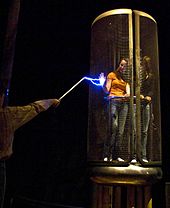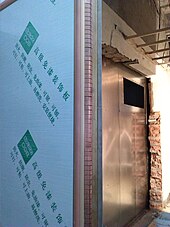使用者:DoroWolf/沙盒/法拉第籠
| 這是DoroWolf/沙盒的使用者頁面。使用者沙盒是使用者頁面的子頁面,屬於使用者的測試區,不是維基百科條目。 公用沙盒:主沙盒 | 使用指南沙盒一、二 | 模板沙盒 | 更多…… 此使用者頁面的子頁面: 外觀選項: 用字選項: 如果您已經完成草稿,可以請求志願者協助將其移動到條目空間。 |



法拉第籠(英語:Faraday cage),又稱法拉第屏蔽罩(英語:Faraday shield),是一種用於阻擋電磁場的外殼。法拉第籠可由導電材料的連續覆蓋物形成,或由此類材料的網組成。法拉第籠以科學家麥可·法拉第的名字命名,他於1836年發明了法拉第籠。[1]
法拉第籠的工作原理為外部電場導致籠的導電材料內的電荷分佈,從而抵消了籠內部的場效應。這種現象通常用於在設備測試或校準期間保護敏感電子設備免受外部射頻干擾。它們還用於保護人員和設備免受雷擊和靜電放電等實際電流的影響,因為封閉的籠子在封閉空間的外部傳導電流,而沒有電流穿過內部。
歷史
編輯1836年,麥可·法拉第觀察到帶電導體上的多餘電荷僅存在於其外部,對其內部的任何物體沒有影響。為了證明這一事實,他建造了一個塗有金屬箔的房間,並讓靜電發生器的高壓放電擊中房間的外部。他用驗電器顯示房間牆壁內部不存在電荷。
雖然這種籠子效應歸因於麥可·法拉第1843年進行的著名冰桶實驗,但班傑明·富蘭克林在1755年觀察到這種效應,他將懸掛在線上的不帶電軟木球從帶電金屬罐的開口處放下。用他的話說,「軟木塞不像在外部那樣被吸引到罐子的內部,雖然它接觸到了罐子的底部,但當它被拉出來時,並沒有像接觸到外部一樣帶電。這種事實是奇特的。」富蘭克林發現了現在所謂的法拉第籠的行為(基於法拉第後來的實驗,重複了富蘭克林的軟木塞和罐子)。[2]
Operation
編輯Continuous
編輯A continuous Faraday shield is a hollow conductor. Externally or internally applied electromagnetic fields produce forces on the charge carriers (usually electrons) within the conductor; the charges are redistributed accordingly due to electrostatic induction. The redistributed charges greatly reduce the voltage within the surface, to an extent depending on the capacitance; however, full cancellation does not occur.[3]
Interior charges
編輯If a charge is placed inside an ungrounded Faraday shield without touching the walls (let's denote this charge quantity as +Q), the internal face of the shield becomes charged with −Q, leading to field lines originating at the charge and extending to charges inside the inner surface of the metal. The field line paths in this inside space (to the endpoint negative charges) are dependent on the shape of the inner containment walls. Simultaneously +Q accumulates on the outer face of the shield. The spread of charges on the outer face is not affected by the position of the internal charge inside the enclosure, but rather determined by the shape of outer face. So for all intents and purposes, the Faraday shield generates the same static electric field on the outside that it would generate if the metal were simply charged with +Q. See Faraday's ice pail experiment, for example, for more details on electric field lines and the decoupling of the outside from the inside. Note that electromagnetic waves are not static charges.
If the cage is grounded, the excess charges will be neutralized as the ground connection creates an equipotential bonding between the outside of the cage and the environment, so there is no voltage between them and therefore also no field. The inner face and the inner charge will remain the same so the field is kept inside.
Exterior fields
編輯- Mn–Zn – magnetically soft ferrite
- Al – metallic aluminum
- Cu – metallic copper
- steel 410 – magnetic stainless steel
- Fe–Si – grain-oriented electrical steel
- Fe–Ni – high-permeability permalloy (80%Ni–20%Fe)
Effectiveness of shielding of a static electric field is largely independent of the geometry of the conductive material; however, static magnetic fields can penetrate the shield completely.
In the case of a varying electromagnetic fields, the faster the variations are (i.e., the higher the frequencies), the better the material resists magnetic field penetration. In this case the shielding also depends on the electrical conductivity, the magnetic properties of the conductive materials used in the cages, as well as their thicknesses.
A good idea of the effectiveness of a Faraday shield can be obtained from considerations of skin depth. With skin depth, the current flowing is mostly in the surface, and decays exponentially with depth through the material. Because a Faraday shield has finite thickness, this determines how well the shield works; a thicker shield can attenuate electromagnetic fields better, and to a lower frequency.
Faraday cage
編輯Faraday cages are Faraday shields which have holes in them and are therefore more complex to analyze. Whereas continuous shields essentially attenuate all wavelengths whose skin depth in the hull material is less than the thickness of the hull, the holes in a cage may permit shorter wavelengths to pass through or set up "evanescent fields" (oscillating fields that do not propagate as EM waves) just beyond the surface. The shorter the wavelength, the better it passes through a mesh of given size. Thus, to work well at short wavelengths (i.e., high frequencies), the holes in the cage must be smaller than the wavelength of the incident wave.
Examples
編輯- Faraday cages are routinely used in analytical chemistry to reduce noise while making sensitive measurements.
- Faraday cages, more specifically dual paired seam Faraday bags, are often used in digital forensics to prevent remote wiping and alteration of criminal digital evidence.
- The U.S. and NATO Tempest standards, and similar standards in other countries, include Faraday cages as part of a broader effort to provide emission security for computers.
- Automobile and airplane passenger compartments are essentially Faraday cages, protecting passengers from electric charges, such as lightning
- Electronic components in automobiles and aircraft utilize Faraday cages to protect signals from interference. Sensitive components may include wireless door locks, navigation/GPS systems, and lane departure warning systems. Faraday cages and shields are also critical to vehicle infotainment systems (e.g. radio, Wi-Fi, and GPS display units), which may be designed with the capability to function as critical circuits in emergency situations.[4][5]
- A booster bag (shopping bag lined with aluminium foil) acts as a Faraday cage. It is often used by shoplifters to steal RFID-tagged items.[6]
- Similar containers are used to resist RFID skimming.
- Elevators and other rooms with metallic conducting frames and walls simulate a Faraday cage effect, leading to a loss of signal and "dead zones" for users of cellular phones, radios, and other electronic devices that require external electromagnetic signals. During training, firefighters, and other first responders are cautioned that their two-way radios will probably not work inside elevators and to make allowances for that. Small, physical Faraday cages are used by electronics engineers during equipment testing to simulate such an environment to make sure that the device gracefully handles these conditions.[來源請求]
- Properly designed conductive clothing can also form a protective Faraday cage. Some electrical linemen wear Faraday suits, which allow them to work on live, high-voltage power lines without risk of electrocution. The suit prevents electric current from flowing through the body, and has no theoretical voltage limit. Linemen have successfully worked even the highest voltage (Kazakhstan's Ekibastuz–Kokshetau line 1150 kV) lines safely.[來源請求]
- Austin Richards, a physicist in California, created a metal Faraday suit in 1997 that protects him from tesla coil discharges. In 1998, he named the character in the suit Doctor MegaVolt and has performed all over the world and at Burning Man nine different years.
- The scan room of a magnetic resonance imaging (MRI) machine is designed as a Faraday cage. This prevents external RF (radio frequency) signals from being added to data collected from the patient, which would affect the resulting image. Technologists are trained to identify the characteristic artifacts created on images should the Faraday cage be damaged, such as during a thunderstorm.
- A microwave oven utilizes a partial Faraday shield (on five of its interior's six sides) and a partial Faraday cage, consisting of a wire mesh, on the sixth side (the transparent window), to contain the electromagnetic energy within the oven and to protect the user from exposure to microwave radiation.
- Plastic bags that are impregnated with metal are used to enclose electronic toll collection devices whenever tolls should not be charged to those devices, such as during transit or when the user is paying cash.[來源請求]
- The shield of a screened cable, such as USB cables or the coaxial cable used for cable television, protects the internal conductors from external electrical noise and prevents the RF signals from leaking out.
- Electronic components in some music instruments, such as in an electric guitar, are protected by faraday cages made from copper or aluminum foils which protect the instrument's electromagnetic pickups from interference from speakers, amplifiers, stage lights, and other musical equipment.
- Some buildings, such as prisons, are constructed as a faraday cage because they have reasons to block both incoming and outgoing cellphone calls by prisoners.[7][8]
See also
編輯References
編輯- ^ Michael Faraday. Encarta. [20 November 2008]. (原始內容存檔於8 May 2006).
- ^ Krauss, J. D. (1992) Electromagnetics, 4th ed., McGraw-Hill. ISBN 0-07-035621-1
- ^ Chapman, S. Jonathan; Hewett, David P.; Trefethen, Lloyd N. Mathematics of the Faraday Cage (PDF). SIAM Review. 2015, 57 (3): 398–417. doi:10.1137/140984452.
- ^ Understanding EMI/RFI Shielding to Manage Interference. Ceptech. [2020-04-23].
- ^ Reliability Becomes The Top Concern In Automotive. Passive Components Blog. 2019-02-12 [2020-04-23].
- ^ Hamill, Sean. As Economy Dips, Arrests for Shoplifting Soar. The New York Times. 22 December 2008 [12 August 2009].
- ^ Prose, Mark. Imperfect System. AARP Magazine. No. April / May 2020: 6.
with a Faraday shield would render the phones' transmitting and receiving functions useless
- ^ REDACTED FOR PUBLIC INSPECTION: Contraband phone task force status report (PDF). CTIA. April 26, 2019.